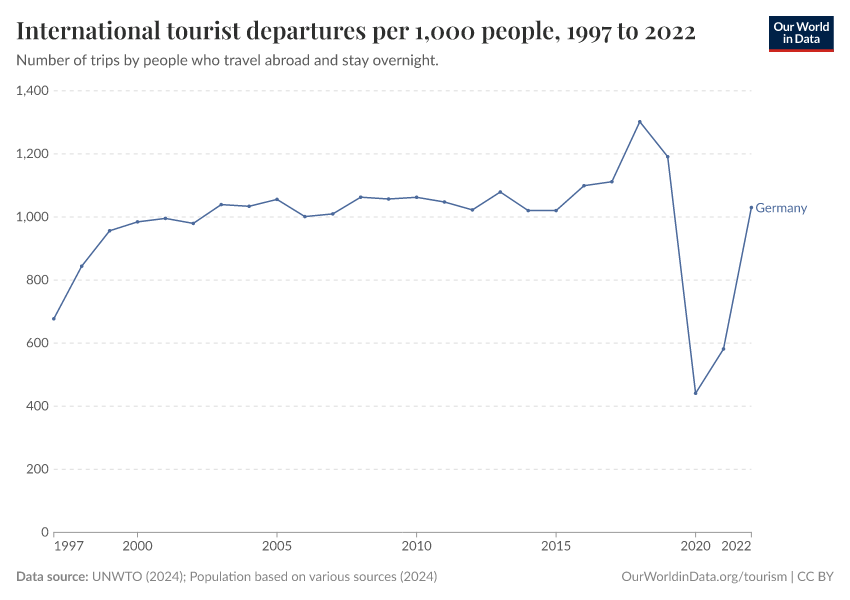International tourist departures per 1,000 people

What you should know about this indicator
- When an individual leaves its residence country multiple times within a year, each visit is counted as a separate departure.
- As a result, the number of departures does not necessarily reflect the number of individuals traveling, as one person can generate multiple departures.
- Per "1,000 people" in the context of international tourist departures refers to the calculation of departures per 1,000 individuals within the population of the country.
- This approach enables standardized comparison and analysis of data or rates, ensuring consistency across different population sizes.
- For instance, if there are "10 tourist departures per 1,000 people," it means that among every 1,000 individuals in the population, there are 10 instances of international departures by people who travel abroad and stay overnight.
- This indicator provides an insight into the level of international tourism in the country of reference.
What you should know about this indicator
- When an individual leaves its residence country multiple times within a year, each visit is counted as a separate departure.
- As a result, the number of departures does not necessarily reflect the number of individuals traveling, as one person can generate multiple departures.
- Per "1,000 people" in the context of international tourist departures refers to the calculation of departures per 1,000 individuals within the population of the country.
- This approach enables standardized comparison and analysis of data or rates, ensuring consistency across different population sizes.
- For instance, if there are "10 tourist departures per 1,000 people," it means that among every 1,000 individuals in the population, there are 10 instances of international departures by people who travel abroad and stay overnight.
- This indicator provides an insight into the level of international tourism in the country of reference.
Sources and processing
This data is based on the following sources
How we process data at Our World in Data
All data and visualizations on Our World in Data rely on data sourced from one or several original data providers. Preparing this original data involves several processing steps. Depending on the data, this can include standardizing country names and world region definitions, converting units, calculating derived indicators such as per capita measures, as well as adding or adapting metadata such as the name or the description given to an indicator.
At the link below you can find a detailed description of the structure of our data pipeline, including links to all the code used to prepare data across Our World in Data.
Reuse this work
- All data produced by third-party providers and made available by Our World in Data are subject to the license terms from the original providers. Our work would not be possible without the data providers we rely on, so we ask you to always cite them appropriately (see below). This is crucial to allow data providers to continue doing their work, enhancing, maintaining and updating valuable data.
- All data, visualizations, and code produced by Our World in Data are completely open access under the Creative Commons BY license. You have the permission to use, distribute, and reproduce these in any medium, provided the source and authors are credited.
Citations
How to cite this page
To cite this page overall, including any descriptions, FAQs or explanations of the data authored by Our World in Data, please use the following citation:
“Data Page: International tourist departures per 1,000 people”, part of the following publication: Bastian Herre and Veronika Samborska (2023) - “Tourism”. Data adapted from UNWTO, Various sources. Retrieved from https://archive.ourworldindata.org/20250925-233948/grapher/international-tourist-departures-per-1000.html [online resource] (archived on September 25, 2025).How to cite this data
In-line citationIf you have limited space (e.g. in data visualizations), you can use this abbreviated in-line citation:
UNWTO (2024); Population based on various sources (2024) – with major processing by Our World in DataFull citation
UNWTO (2024); Population based on various sources (2024) – with major processing by Our World in Data. “International tourist departures per 1,000 people” [dataset]. UNWTO, “145 key tourism statistics”; Various sources, “Population” [original data]. Retrieved December 29, 2025 from https://archive.ourworldindata.org/20250925-233948/grapher/international-tourist-departures-per-1000.html (archived on September 25, 2025).